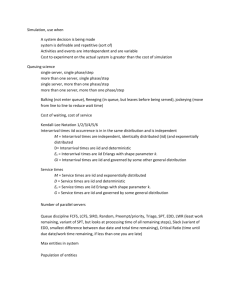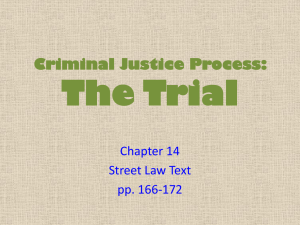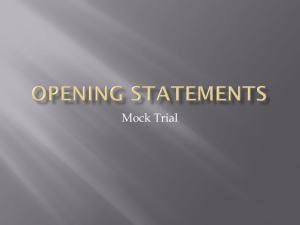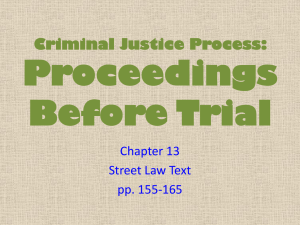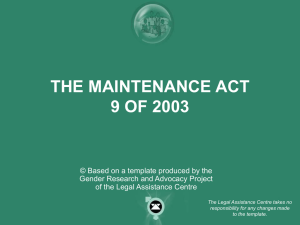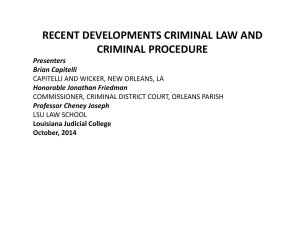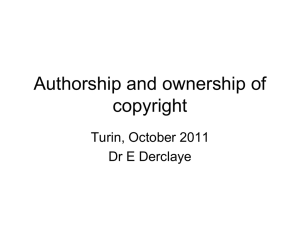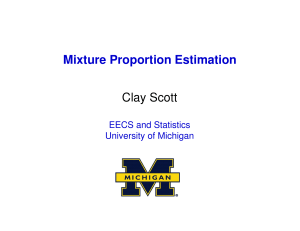U.S. v, Marland Maynor
advertisement
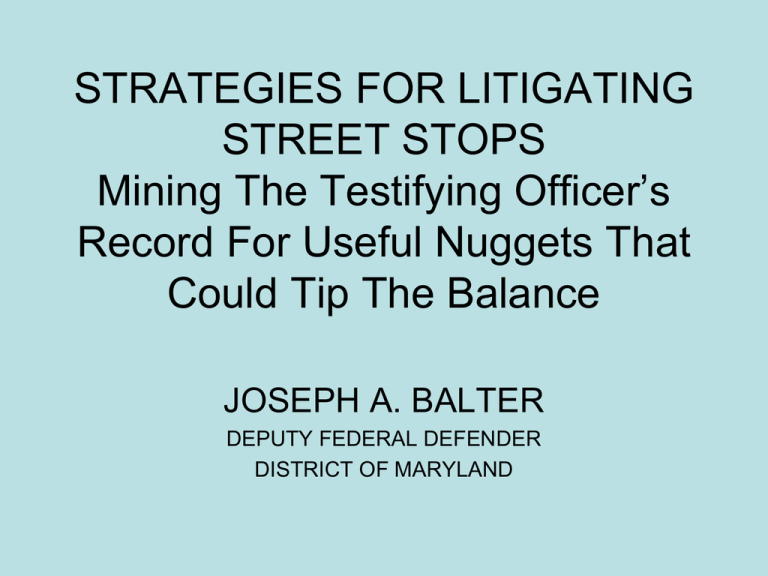
STRATEGIES FOR LITIGATING STREET STOPS Mining The Testifying Officer’s Record For Useful Nuggets That Could Tip The Balance JOSEPH A. BALTER DEPUTY FEDERAL DEFENDER DISTRICT OF MARYLAND INTRODUCTION • Presentation based on suppression motion in U.S. v. Marland Maynor, GWR-13-0371, a garden variety gun and drug case arising from Baltimore City street stop. • Presentation addresses two types of records that provided useful cross examination material of officers: – Baltimore City IID Files – Baltimore City charging statements filed in other cases Baltimore City Statement of Charges • • • • • • • • • LOCATION TO BE USED FOR THE ILLEGAL DISTRIBUTION OF NARCOTICS NUMEROUS NARCOTICS ARRESTS IN AND AROUND THE STORE. 2 INDIVIDUALS QUICKLY WALKED INSIDE THE STORE. OBSERVED THE DEF. STANDING INSIDE THE STORE. RECOGNIZED DEF. AS THE SAME INDIVIDUAL WHO WAS ARRESTED AT THE SAME LOCATION LAST WEEK ON NARCOTICS CHARGES. UNIDENTIFIED INDIVIDUAL CALLED OUT TO DEF. WHO IMMEDIATELY TURNED AWAY AND PLACED A SMALL OBJECT INTO HIS WAISTBAND WITH HIS LEFT HAND BELIEVING THAT DEF. WAS IN POSSESSION OF CDS APPROACHED DEF. AND RECOVERED A PLASTIC BAG CONT. (5) GEL CAPS FROM HIS WAISTBAND AREA. PLACED UNDER ARREST. (post arrest statement leads to ACCA gun seizure) [NOTE: OFFICER DESCRIBED “SMALL OBJECT” IN DEF. HAND WITHOUT PROVIDING FURTHER DETAIL] Government Response to Motion to Suppress Evidence Def. immediately turned away from the detectives and attempted to secrete a plastic bag inside his waist band. [NOTE: OFFICER ALLEGES HE OBSERVED “PLASTIC BAG”, RATHER THAN “SMALL OBJECT”] Detective observed a plastic bag which based on his training and experience believed the plastic bag contained CDS. The detectives had probable cause to arrest and anything recovered from him as part of a search incident to that legal arrest is admissible and therefore the Defendant’s motion should be denied. [NOTE: GOVERNMENT ALLEGED ONLY PROBABLE CAUSE TO ARREST, NOT REASONABLE SUSPICION FOR INVESTIGATORY STOP] Defense Reply • While it may be permissible for the Court to consider the factors cited by the government, it is also clear that the existence of any of these factors alone would not be sufficient to provide probable cause.. See United States v. Sprinkle, 106 F. 3d 613, 617 (4 th Cir. 1997)(no reasonable suspicion where officers aware of defendant’s past criminal record; events occurred in a high crime area; and defendant attempted to hide his face and closely huddled with another person in vehicle); United States v. Powell, 666 F.3d 180, 188 (4 th Cir. 2011)(officers’ knowledge of prior record alone not sufficient for reasonable suspicion); United States v. Davis, 94 F.3d 1465, 1469 (10th Cir.1996) ([Defendant’s] prior criminal record “is not, standing alone, sufficient to create reasonable suspicion.”); United States v. Massenburg, 654 F. 3d 480, 486 (4th Cir. 2011)(defendant’s nervous or furtive behavior, high crime area standing alone not sufficient to establish reasonable suspicion); United States v. Foster, 634 F. 3d 243; 246-47 (4th Cir. 2011) (combination of factors including officer’s knowledge of defendant’s prior record, defendant being in crouched position in vehicle, defendant engaging in erratic activity with his arms, not sufficient to establish reasonable suspicion; court noting disapprovingly of “ the inclination of government to use whatever facts necessary to establish reasonable suspicion”); In re Jeremy P., 197 Md. App.1, 13 (2011) (police officer’s observations of a suspect making an adjustment in the vicinity of his waistband alone does not give rise to reasonable suspicion). • [NOTE: DEFENSE ONLY REPLIES TO PROBABLE CAUSE STANDARD, NOT REASONABLE SUSPICION STANDARD. AT THE MOTIONS HEARING DEFENSE ARGUED THAT GOVERNMENT SHOULD BE HELD TO THE PROBABLE CAUSE STANDARD, A HIGHER STANDARD THAN REASONABLE SUSPICION] IID FILES: Initiating the Process • Subpoena • Demand letter to government – We request disclosure to the defense of all disciplinary files, related to any and all allegations including, but not limited to: official misconduct, excessive use of force, false statements, misrepresentations, stealing, misappropriation, dishonest act, or racial discrimination or bias. Alternatively, we request notification of the existence of the material so that the parties may request in camera review by the Court. – We regard such materials from the officers’ personnel files to be Brady material that must be disclosed. Even unadjudicated acts may trigger rights under the Fifth and Sixth Amendments to the United States Constitution and Rule 608(b) and Rule 404(b) of the Federal Rules of Evidence. See Davis v. Alaska, 415 U.S. 308 (1974) (defendant’s 6th amendment confrontation rights violated when trial court precluded cross examination about witness’ juvenile record and probation status). • Practice Tips – – – – In Camera review Government disclosure schedule Government summaries of files Protective Orders IID FILES: Review For Useful Information • Substantiated/Non-substantiated complaints – Substantiated complaints rare – Government seeks to avoid using officer with serious IID record • • Departmental Complaints Citizen Complaints – Arrestee complaints about excessive force, planted evidence, verbal abuse, theft, destruction of property, racial bias – Arrestee rarely follows up on initial complaint • Theories for Admissibility – F.R.E. 608(b)- specific instances of conduct to attack character for truthfulness – F.R.E. 404(b)- prior bad act offered to show motive, opportunity, intent… (to act in violation of defendant’s rights under the 4 th amendment). • Case Law – United States v. Leake, 642 F.2d 715(4th Cir.1981)(Fed.R.Evid.608(b) authorizes inquiry only into instances of misconduct which are relevant to character for untruthfulness) – United States v. Harris, 2014 WL 128814 (4th cir. Jan. 2014)(affirming denial of use of non-substantiated IID allegations for cross examination officers at trial) IID FILE Matching IID Information with a Defense Theory • Defense theories to be supported by IID information – The police failure to record the names of the 2 suspects stopped along with the defendant showed a motive, intent or plan to avoid recording information about witness identity that could provide useful or exculpatory information to the defendant. – The police had a pattern of stop and frisk activity not supported by articulable suspicion which supported the inference the search of the defendant was a random stop and frisk not supported by articulable suspicion. • IID File; citizen complaint – The police officers conducted a street stop of a ten year old boy walking down the street; police searched the inside of his pants for drugs ; no drugs recovered. The boy’s mother complained that the police had searched without cause and used abusive language in addressing her son. Matching IID Information (2) • Results of IID investigation – Charges of misconduct/improper search and discourtesy not sustained due to lack of independent witnesses to support – Officer cited for failure to issue a Citizen Contact Receipt, referred for command discipline. • Although complaint charges not sustained, IID File information provided basis for impeachment that supported defense theories – Officer acknowledged incident in which he conducted a search of a ten year old boy that resulted in no seizure of drugs. – Officer acknowledged that he was disciplined for failure to to issue Citizen Contact Receipt which provides a record for each frisk. – The 2 persons stopped with the defendant were not issued citizen contact receipts; no drugs were recovered from them; no arrests made. – Compliance with the requirement for Citizen Contact Receipt would have resulted in the identification of the 2 witnesses. – Identification of the 2 witnesses would have supported defense theory that the officers made many random stop and frisk without articulable suspicion. – Defendant was denied evidence that would have established he was subjected to a random stop and frisk in violation of his rights under the 4 th amendment. Use of Charging Documents in Non-Related Cases to Impeach • Issue: – The government’s case is substantially stronger if the court finds that the officer observed a “plastic bag” in the defendant’s hand, rather than a “small object”. – The officer will testify at the hearing that he observed defendant stuff a “plastic bag” into his waistband. If cross examined on the “prior inconsistent statement” of describing a “small object,” the officer will most likely bridge the 2 terms by characterizing “object” as a generic term that includes “plastic bag.” • Cross Examination objective: – Demonstrate that original use of term “small object” in the charging document to describe what was observed in the defendant’s hand was accurate; the subsequent description of a “plastic bag” was recent fabrication and a material deviation from the statement made in the charging documents. • Non-Related case information – Charging statements from other cases will show the variety of terms used by officer to describe CDS observations in other instances. Collecting Charging Documents in Non-Related Cases • Md. Judicial Case Search allows for search of all cases charged by officer – • Collect charging documents in other CDS cases that describe what the officer observed in the hand of a suspect prior to a drug arrest. – • • • Copies of charging documents available at court clerk’s office Non-Related charging documents revealed a variety of descriptions that officer used to describe what he observed in the hand of a suspect prior to drug arrest – – – – – • Search by any time period “Object” “Object(s)” “Objects in size and shape resembling CDS packaged for sale” “Gel caps” “Color top vials” Variety of description supported inference that officer did attempt to accurately describe specific characteristic of his observations in each individual case. The term “small object” was the least descriptive term used by the officer to describe observations of suspect CDS. Officer said what he meant and meant what he said


